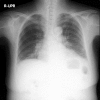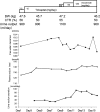Successful treatment with tolvaptan to control blood volume and hyponatremia in a chronic kidney disease patient
- PMID: 28509063
- PMCID: PMC5411527
- DOI: 10.1007/s13730-012-0018-1
Successful treatment with tolvaptan to control blood volume and hyponatremia in a chronic kidney disease patient
Abstract
We report a case of successful treatment with tolvaptan (15 mg/day) in a 73-year-old female patient with chronic kidney disease (CKD) stage 5 due to diabetic nephropathy and renal sclerosis for volume control and loop diuretic-induced hyponatremia. Her creatinine clearance has remained at 7-10 ml/min for the last 6 months. She was treated by dietary and drug therapy, namely, antihypertensives (nifedipine: 40 mg/day, olmesartan: 20 mg/day) and loop diuretics (azosemide: 40-120 mg/day), for CKD and concomitant diseases of hypertension and diabetic mellitus. She developed loop diuretic-induced hyponatremia (120 mmol/l) by increased sodium excretion, but the diuretic was required for the control of volume overload. Hence, azosemide was suspended and tolvaptan (15 mg/day) was administered. After tolvaptan treatment, the plasma sodium level gradually increased to a normal level (135-140 mmol/l) and volume overload was improved. Urine volume was maintained at about 1000 ml/day with low sodium excretion (<40 mmol/day) and increased free water clearance. These results suggest that tolvaptan may be effective for volume control and diuretic-induced hyponatremia in CKD patients.
Keywords: Chronic kidney disease; Hyponatremia; Tolvaptan.
Figures
Similar articles
-
[Electrolyte and acid-base balance disorders in advanced chronic kidney disease].Nefrologia. 2008;28 Suppl 3:87-93. Nefrologia. 2008. PMID: 19018744 Spanish.
-
Tolvaptan, an oral vasopressin antagonist, in the treatment of hyponatremia in cirrhosis.J Hepatol. 2012 Mar;56(3):571-8. doi: 10.1016/j.jhep.2011.08.020. Epub 2011 Oct 23. J Hepatol. 2012. PMID: 22027579 Clinical Trial.
-
Diuretic usage for protection against end-organ damage in liver cirrhosis and heart failure.Hepatol Res. 2017 Jan;47(1):11-22. doi: 10.1111/hepr.12700. Epub 2016 May 11. Hepatol Res. 2017. PMID: 26990144 Review.
-
Tolvaptan and the role of kidney aquaporin-2 abundance in managing volume overload in patients with CKD.Clin Kidney J. 2024 Oct 4;17(10):sfae303. doi: 10.1093/ckj/sfae303. eCollection 2024 Oct. Clin Kidney J. 2024. PMID: 39449995 Free PMC article.
-
Tolvaptan, an orally active vasopressin V(2)-receptor antagonist - pharmacology and clinical trials.Cardiovasc Drug Rev. 2007 Spring;25(1):1-13. doi: 10.1111/j.1527-3466.2007.00001.x. Cardiovasc Drug Rev. 2007. PMID: 17445084 Review.
Cited by
-
Dual Impact of Tolvaptan on Intracellular and Extracellular Water in Chronic Kidney Disease Patients with Fluid Retention.Intern Med. 2016;55(19):2759-2764. doi: 10.2169/internalmedicine.55.7133. Epub 2016 Oct 1. Intern Med. 2016. PMID: 27725533 Free PMC article. Clinical Trial.
References
-
- Buckalew VM, Jr, Berg RL, Wang SR, Porush JG, Rauch S, Schulman G. Prevalence of hypertension in 1,795 subjects with chronic renal disease: the modification of diet in renal disease study baseline cohort. Modification of Diet in Renal Disease Study Group. Am J Kidney Dis. 1996;28(6):811–821. doi: 10.1016/S0272-6386(96)90380-7. - DOI - PubMed
LinkOut - more resources
Full Text Sources



